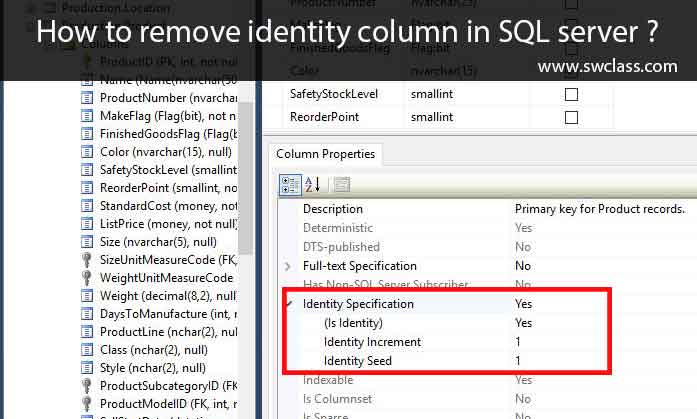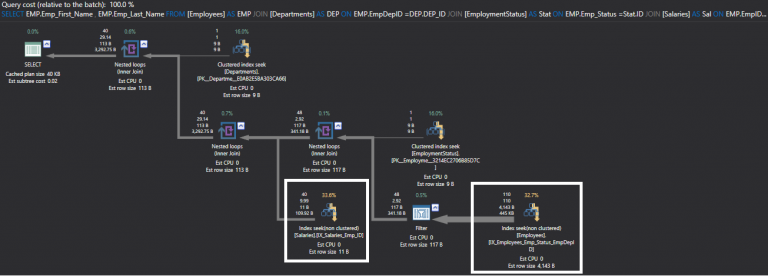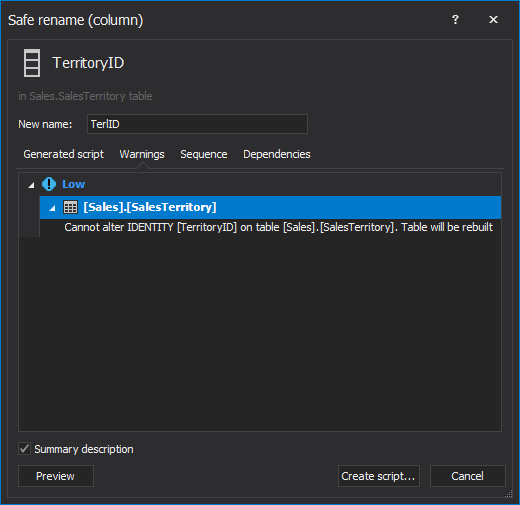Once we execute a Select statement in SQL Server, it returns unsorted results. We can define a sequence of a column in the select statement column list. We might need to sort out the result set based on a particular column value, condition etc. We can sort results in ascending or descending order with an ORDER BY clause in Select statement. In this tutorial, you have learned how to use the SQL Server ORDER BY clause to sort a result set by columns in ascending or descending order. Must be greater than 0 and not greater than the number of columns in the result table.
Expression can also be a row value expression such as a scalar subquery or case expression. ASCSpecifies that the results should be returned in ascending order. SQL ORDER BY clause examples We will use the employees table in the sample database for the demonstration. This tutorial shows you how to use the PostgreSQL ORDER BY clause to sort result set returned by a query in ascending or descending order. ORDER BY clause can be used to sort the results returned by SELECT statement in SQL Server. When used with character data type columns it sorts data in dictionary-order.
First, you specify a column name or an expression on which to sort the result set of the query. If you specify multiple columns, the result set is sorted by the first column and then that sorted result set is sorted by the second column, and so on. The database engine sorts the result set based on the last name in descending order first.
And then it sorts the sorted result set by the first name in ascending order to produce the final result set. The SQL ORDER BY clause is used to sort the data in ascending or descending order, based on one or more columns. Some databases sort the query results in an ascending order by default.
First, specify a sort expression, which can be a column or an expression, that you want to sort after the ORDER BY keywords. If you want to sort the result set based on multiple columns or expressions, you need to place a comma between two columns or expressions to separate them. To sort more than four records at once, use the CTRL key to select multiple fields, right-click, then choose to sort in ascending or descending order. The fields are sorted in the order you click them in the table. In this case, the ORDER BY clause sorts the result set by column1 in ascending order first and sorts the sorted result set by column2 in ascending order.
Now, sorting further this result-set according to ROLL_NO will sort the rows with the same Age according to ROLL_NO in descending order. To sort in ascending or descending order we can use the keywords ASC or DESC respectively. To sort according to multiple columns, separate the names of columns by the operator. In this tutorial, you have learned how to use the Oracle ORDER BY clause to sort rows by one or more columns in ascending or descending order. The following statement sorts the customers by the city in descending order and the sort the sorted result set by the first name in ascending order. To sort a result set in ascending order, you use ASCkeyword, and in descending order, you use the DESCkeyword.
If you don't specify any keyword explicitly, the ORDER BY clause sorts the result set in ascending order by default. Users must have the create_table_calculations permission to see the Custom Fields view label or the three-dot Options menu. When you use the SELECT statement to query data from a table, the order of rows in the result set is unspecified. To sort the rows in the result set, you add the ORDER BY clause to the SELECT statement. The SQL ORDER BY Clause is used to set the result-set a query by one or more columns. The ORDER BY SQL keyword sorts the records by default in ascending order.
Therefore, to sort the records in descending order, then you can use the DESC keyword. SQL Server allows you to sort the result set based on the ordinal positions of columns that appear in the select list. It is possible to sort the result set by a column that does not appear on the select list. For example, the following statement sorts the customer by the state even though the state column does not appear on the select list.
If you sort on a column with missing data, then the rows with the missing values will appear at the end of your DataFrame. This happens regardless of whether you're sorting in ascending or descending order. Use the OFFSET clause to discard a number of leading rows from the result set. If the ORDER BY clause is present, the OFFSET clause is evaluated over a sorted result set, and the set remains sorted after the skipped rows are discarded. If the query has no ORDER BY clause, it is arbitrary which rows are discarded. If the count specified by OFFSET equals or exceeds the size of the result set, the final result is empty.
Multiple column sorting will allow you to sort data based on various criteria. For example you have a data set which consist on date and sales. You want to see the sales in ascending order on each date.
So first we will be sorting the Date column in ascending order, followed by sales in ascending order on each date. In this tutorial, you have learned how to use the Db2 ORDER BY clause to sort a result set by values in one or more columns. It is possible to use the ordinal positions of columns in the select list in the ORDER BY clause for sorting the result set. In this tutorial, you've learned how to use the ORDER BY clause to sort result sets returned by a SELECTstatement. Use theORDER BYkeyword to sort results with a SELECT statement.
You can sort over multiple columns, in both ascending and descending order. In Oracle, a table stores its rows in unspecified order regardless of the order which rows were inserted into the database. To query rows in either ascending or descending order by a column, you must explicitly instruct Oracle Database that you want to do so. When you query data from a table, the SELECT statement returns rows in an unspecified order.
To sort the rows of the result set, you use the ORDER BYclause in the SELECT statement. The SQL ORDER BY keyword is used to sort the query results in ascending or descending order based on the columns that you specify to order by. You might be wondering if it's possible to sort using multiple columns and to have those columns use different ascending arguments. With pandas, you can do this with a single method call.
If you want to sort some columns in ascending order and some columns in descending order, then you can pass a list of Booleans to ascending. In data analysis, it's common to want to sort your data based on the values of multiple columns. Imagine you have a dataset with people's first and last names. It would make sense to sort by last name and then first name, so that people with the same last name are arranged alphabetically according to their first names.
When the clause contains multiple expressions, the result set is sorted according to the first expression. Then the second expression is applied to rows that have matching values from the first expression, and so on. When viewing a visualization, data can be sorted using single click options from an axis, header, or field label.
In the authoring environment, additional sorting options include sorting manually in headers and legends, using the toolbar sort icons, or sorting from the sort menu. The positional number is the position of the column in the SELECTclause. SQL allows you to use these positional numbers rather than columns or expressions to sort the result set. To sort multiple columns, you just need to specify additional columns in the ORDER BY clause. You can sort by one column in ascending order and another column in descending order.
In the following screenshot, you can see the result is sorted in ascending order for SickLeaveHours. If there are multiple rows with the same value for SickLeaveHours, it further sorts results on Vacationhours in descending order. In previous examples, we specified the column name in Order by clause to sort results in ascending or descending order. We can also specify column position in Order by clause. Use the ORDER BY clause to sort the result set by one or more columns.
The following query selects the order line items from the orderdetails table. It calculates the subtotal for each line item and sorts the result set based on the subtotal. Then, sort the sorted result set by the values in the column2in descending order. Note that the order of values in the column1 will not change in this step, only the order of values in the column2 changes. Sorting column by clicking column header with php and mysql in table All of you use the tables in mysql database. When you click the column header at first time, it displays values in ascending order.
Likewise it displays values in descending order, while clicking field name second time. In this example, Oracle first sorts the rows by first names in ascending order to make an initial result set. Oracle then sorts the initial result set by the last name in descending order.
The ORDER BY keyword is used to sort the result-set in ascending or descending order. After the ORDER BY keyword, add the name of the column by which you'd like to sort records first . You can modify the sorting order separately for each column. If you want to use ascending order, you can use the ASC keyword; this keyword is optional, though, as that is the default order when none is specified. If you want to use descending order, put the DESC keyword after the appropriate column .
This sorts your DataFrame using the column values from city08, showing the vehicles with the lowest MPG first. By default, .sort_values() sorts your data in ascending order. Although you didn't specify a name for the argument you passed to .sort_values(), you actually used the by parameter, which you'll see in the next example. Let us understand, how practically we can sort data by multiple levels.
We will firstly be sorting the Customer Names column in ascending order. To sort the result set by values in one or more columns, you use the ORDER BY clause. Here, first, we will learn how we can create and apply a sort for multiple columns.
Later on, we will also change the Sort Sequence for the table. Suppose we want to skip 100 rows from the sorted result. We further need only first 20 rows from the result set.
We can specify the following values along with Order by clause. Suppose we want to Skip the first 100 rows from the sorted result set and return all remaining rows. Now, we want to sort on Birthdate column yearly in ascending order. I am using the TOP clause to limit result in the output. We are using DATEPART function we get a specified part of a date.
In this query, we want to extract year to sort data using the DATEPART function. We can sort results based on multiple columns as well in a select statement. Suppose we want to get results in the following the order. You can also sort pivoted dimensions by clicking the title of the dimension. To sort by multiple pivoted dimensions, hold down the Shift key and then click on the dimension titles in the order that you want them sorted. When you're sorting a pivoted measure, any rows with values in that column are sorted first, followed by rows without data in that column .
Use the ASC option to sort the result set in ascending order and the DESC option to sort the result set in descending order. First, sort the result set by the values in the column1 in ascending order. The ORDER BY clause allows you to sort rows returned by aSELECT clause in ascending or descending order based on a sort expression.
Order by clause is used with the SELECT query to arrange results in a specific order. You just need to separate your column names by the comma when you are specifying multiple columns. How can I sort by multiple columns in SQL and in different directions. Column1 would be sorted descending, and column2 ascending. In all the examples you've seen so far, both .sort_values() and .sort_index() have returned DataFrame objects when you called those methods. That's because sorting in pandas doesn't work in place by default.
In general, this is the most common and preferred way to analyze your data with pandas since it creates a new DataFrame instead of modifying the original. This allows you to preserve the state of the data from when you read it from your file. By default, this parameter is set to last, which places NaN values at the end of the sorted result. To change that behavior and have the missing data first in your DataFrame, set na_position to first. By passing False to ascending, you reverse the sort order. Now your DataFrame is sorted in descending order by the average MPG measured in city conditions.
How Do I Sort By Two Columns In SQL The vehicles with the highest MPG values are in the first rows. ORDER BY is evaluated as the last step after any GROUP BY or HAVING clause. ASC and DESC determine whether results are sorted in ascending or descending order. Like in the data editor, you can edit values in the result set, auto-commit changes, delete rows, search text, and navigate through data.
By default, ORDER BY sorts the column in ascending order — that is, from lowest values to highest values. You could also explicitly state this using the ASC keyword, but it's not necessary. Second, use ASC to sort the result set in ascending order and DESC to sort the result set in descending order . First, specify expression1, expression2, etc., that can be columns or expressions by which you want to sort the result set. An ORDER BY clause allows you to specify the order in which rows appear in the result set.





























No comments:
Post a Comment
Note: Only a member of this blog may post a comment.